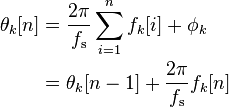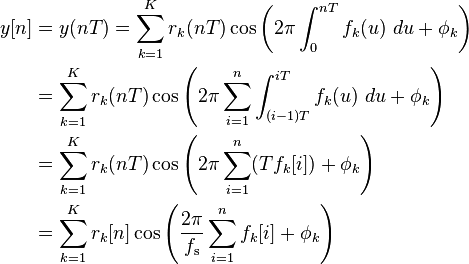Discrete-time Equations
In digital implementations of additive synthesis, discrete-time equations are used in place of the continuous-time synthesis equations. A notational convention for discrete-time signals uses brackets i.e. and the argument can only be integer values. If the continuous-time synthesis output is expected to be sufficiently bandlimited; below half the sampling rate or, it suffices to directly sample the continuous-time expression to get the discrete synthesis equation. The continuous synthesis output can later be reconstructed from the samples using a digital-to-analog converter. The sampling period is .
Beginning with (3),
and sampling at discrete times results in
where
- is the discrete-time varying amplitude envelope
- is the discrete-time backward difference instantaneous frequency.
This is equivalent to
where
 for all
for all
and
Read more about this topic: Additive Synthesis
